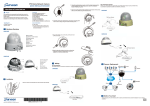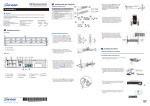Download QIG
Transcript
Box Network Camera Rear View for CAM2311/2331/2331SC/2441/2441SC/2511 3. Connect the lens cable with the DC-Iris/P-Iris connector on the rear side. QUICK INSTALLATION GUIDE Hardware Installation Warning! Accessories Quick Installation Guide x1 ● Product DVD x1 (including manuals) ● Anchors and Mounting Screws x3 ● Camera Stand x1 ● RoHs Compliance x1 ● Hexagonal Wretch x1 (except for -P series) ● CS-ring x1 ( except for -P series) ● Lens (optional, only supplied for -P series ) ● Only qualified service personnel should install and service this product in order to avoid risk of injury from electrical shock and energy hazard. Observe all ESD (Electro-static Discharge) procedures during installation to avoid damage to the camera and its components. DIO PW Tools Required Phillips Screwdriver ● Electric Drill User-provided Items LAN Cable ● PC with Windows (XP or above) and web browsers (Internet Explorer 6.0 or above) installed ● 1 microSDHC 4. Make four screw holes on a flat interface with the electric drill. ● Warning As shown above, the DC-IRIS Black DC power plug must be matched to the correct camera with corresponding DC plug. If matched incorrectly, irreversible damages may occur! Hardware Overview 5. Fasten the screws and anchor bolts to secure the camera stand to the surface. 6. Loosen the CS-ring to adjust the desired angle of the camera. 7. Retighten the ring after the desired angle is achieved. Front View for CAM23xx/24xx/25xx Series 1 Audio In/Out Connector 5 MicroSD/SDHC Card Slot 9 DC-Iris Connector (certain models only) 6 Network Connector 9 P-Iris Connector (CAM2xxxP Series) 10 3 Status LED Indicator 7 I/O Terminal Connector 2 Video Out Connector 4 Reset Button 2 1 8 Power Connector Installation 1. Remove the lens cover on the camera. 8. Connect the power cord to the power port on the rear side. Light Sensor Indent 9. Insert the LAN cable to the LAN port on the rear side. Protrusion 10. The status LED indicator will blink amber to indicate the boot-up sequence has started. Wait until the LED is in a steady green state, indicating the camera boot-up is complete. Rear View for CAM2331P/2331SP/2441P 3 1 Indent Camera Deployment Protrusion DC-IRIS/P-IRIS* 2. Fasten the lens to the camera. NAS FTP Email server Alarm * Sensor * DC-IRIS GND DIO PW DI 1 DI 2 DO RS- 485 A RS- 485 B DC12V Router AUDIO IN AUDIO OUT microSDHC 2 microSDHC Gray Ring DIO PW POWER microSDHC 1 RESET Warning As shown above, the P-IRIS Yellow DC power plug with protrusions or with a gray ring must be matched to the correct camera with corresponding DC plug with indents. If matched incorrectly, irreversible damages may occur! Router MicroSD Microphone * Certain models only © by Surveon Technology, Inc. All rights reserved. QMC 2 X X X 0 0 1 1 1 Speaker 4 1 Before You Start Please prepare a PC with Windows (XP or above) and web browsers (Internet Explorer 6.0 or above) installed. 3 Logging into the System The following information will prompt for logging in: 5 Logging out of the System Logging off of the camera can be performed by closing the browser window. Users can also choose to click the Logout link located at the top of the screen. 1 Software Installation 1 Obtaining IP Address through the IP Utility 1 The IP address can be obtained using the IP Utility in your product CD : 1. Double click Start SearchToolInstall.exe to begin the utility installation. 2.After the installation is complete, click the Auto Search button or click Camera > Search in the menus. Note: For details about accessing camera video using QuickTime or Real Player over RTSP, please refer to the IP Camera user manual. •Username – The username for the domain. Default is always admin. •Password – The password for the domain. Default is always admin. Click OK. Once successfully logged in, live video displays in the center of your browser. 6 Network Configuration 1 Prepare your internet connectivity by clicking Settings > Network > Network Configuration. From here you can configure DHCP, static IP, DNS, PPPoE, or DDNS. DDNS is configured by selecting a DDNS site from its drop-down menu.PPPoE setting changes will take effect after a camera reboot. Provide the username and password from your Internet Service Provider (ISP) within the PPPoE section. When PPPoE is applied, the associated DDNS service must be enabled. The camera search will begin, and a status bar will display the search progress. 3. The details of the camera will display after the search is finished. 4 Installing ActiveX Components in Internet Explorer You may be prompted to install ActiveX® components when accessing the network camera’s Live View page; click Yes when prompted. You will be able to access the camera after installation is completed. Under Windows, this action may require administrator privileges. If the dialog box suggests that you are not allowed to install ActiveX components, try resolving the problem using the following steps: 1. In Internet Explorer, open Tools > Internet Options > Security. Click the Custom Level button. 2. Search for Download signed ActiveX controls. Under this heading select Prompt and then click OK. 1 Note: (1) The search may take up to 2 minutes, depending on your network configuration. (2) If your network does not have DHCP service, the default IP address is 192.168.88.10. 2 Connecting to the Network Camera 1 Launch the web browser (Microsoft ® Internet Explorer 6.0 or higher is recommended). Enter the IP address of the network camera in the address bar of your browser and press enter. You can also Click the Link to Camera button or click to Camera > Link to Camera in the IP Utility menu bar. The camera’s live view webpage will open in a browser window. 3. Continue installing the ActiveX components. 4. After installing ActiveX, go to Tools > Internet Options > Trusted Websites > Sites and add the IP address of the camera.















